Semi-Active Vibration Control of a Non-Collocated Civil Structure Using Evolutionary-Based BELBIC
Abstract
1. Introduction
2. Problem Statement
2.1. The Building Mathematical Model
2.2. Magneto-Rheological Damper Model
2.3. The BEL-Based Control System
2.4. Control System Architecture
2.5. The PSO Optimization Algorithm
3. Simulation Results
Results Discussion
4. Conclusions
Author Contributions
Funding
Conflicts of Interest
Abbreviations
| BELBIC | brain–emotional learning-based intelligent Controller |
| BEL | brain–emotional learning |
| PSO | particle swarm optimization |
| PID | proportional, integral and derivative |
| MR | magneto–rheological |
References
- Jansen, L.M.; Dyke, S.J. Semiactive Control Strategies for MR Dampers: Comparative Study. J. Eng. Mech. 2000, 126, 795–803. [Google Scholar] [CrossRef]
- Min, C.; Dahlmann, M.; Sattel, T. A concept for semi-active vibration control with a serial-stiffness-switch system. J. Sound Vib. 2017, 405, 234–250. [Google Scholar] [CrossRef]
- Lynch, J.P.; Loh, K.J.; Hou, T.C.; Wang, Y.; Yi, J.; Yun, C.B.; Lu, K.; Loh, C.H. Validation case studies of wireless monitoring systems in civil structures. In Proceedings of the 2nd International Conference on Structural Health Monitoring of Intelligent Infrastructure, Shenzhen, China, 16–18 November 2005; pp. 597–604. [Google Scholar]
- Loh, C.H.; Lynch, J.P.; Lu, K.C.; Wang, Y.; Chang, C.M.; Lin, P.Y.; Yeh, T.H. Experimental verification of a wireless sensing and control system for structural control using MR dampers. Earthq. Eng. Struct. Dyn. 2007, 36, 1303–1328. [Google Scholar] [CrossRef]
- Swartz, R.A.; Lynch, J.P. Partial Decentralized Wireless Control Through Distributed Computing for Seismically Excited Civil Structures: Theory and Validation. In Proceedings of the 2007 American Control Conference (ACC ’07), New York, NY, USA, 9–13 July 2007; pp. 2684–2689. [Google Scholar]
- Wang, Y.; Loh, C. Decentralized civil structural control using real-time wireless sensing and embedded computing. Smart Struct. Syst. 2007, 3, 321–340. [Google Scholar] [CrossRef]
- Lynch, J.P.; Wang, Y.; Swartz, R.A.; Lu, K.C.; Loh, C.H. Implementation of a closed-loop structural control system using wireless sensor networks. Struct. Control Health Monit. 2008, 15, 518–539. [Google Scholar] [CrossRef]
- Swartz, R.A.; Lynch, J.P. Strategic Network Utilization in a Wireless Structural Control System for Seismically Excited Structures. J. Struct. Eng. 2009, 135, 597–608. [Google Scholar] [CrossRef]
- Wang, Y.; Lynch, J.; Law, K. Decentralized H∞ controller design for large-scale civil structures. Earthq. Eng. Struct. Dyn. 2009, 38, 377–401. [Google Scholar] [CrossRef]
- Law, K.H.; Wang, Y.; Swartz, A.; Lynch, J.P. Wireless sensing and vibration control of civil structures. In Proceedings of the 2010 IEEE International Conference on Wireless Information Technology and Systems, Honolulu, HI, USA, 28 August–3 September 2010. [Google Scholar]
- Kane, M.B.; Lynch, J.P.; Law, K. Market-based control of shear structures utilizing magnetorheological dampers. In Proceedings of the 2011 American Control Conference, San Francisco, CA, USA, 29 June–1 July 2011. [Google Scholar]
- Swartz, R.A. Reduced-order modal-domain structural control for seismic vibration control over wireless sensor networks. In Proceedings of the 2011 American Control Conference (ACC ’11), San Francisco, CA, USA, 29 June–1 July 2011. [Google Scholar]
- Soto, M.G.; Adeli, H. Multi-agent replicator controller for sustainable vibration control of smart structures. J. Vibroeng. 2017, 19, 4300–4317. [Google Scholar] [CrossRef]
- Winter, B.D.; Swartz, R.A. Low-force magneto–rheological damper design for small-scale structural control. Struct. Control Health Monit. 2017, 24, e1990. [Google Scholar] [CrossRef]
- Abé, M. Structural Monitoring of Civil Structures using Vibration Measurement—Current Practice and Future. In Artificial Intelligence in Structural Engineering; Springer: Berlin/Heidelberg, Germany, 1998; pp. 1–18. [Google Scholar]
- Braz-César, M.B.; Gonçalves, J.; Coelho, J.; de Barros, R.C. Brain Emotional Learning Based Control of a SDOF Structural System with a MR Damper. In Proceedings of the CONTROLO 2016, Guimarães, Portugal, 14–16 June 2016; pp. 547–557. [Google Scholar]
- Braz-César, M.; Coelho, J.P.; Gonçalves, J. Evolutionary-Based BEL Controller Applied to a Magneto–Rheological Structural System. Actuators 2018, 7, 29. [Google Scholar] [CrossRef]
- Yang, F.; Sedaghati, R.; Esmailzadeh, E. Development of LuGre friction model for large-scale magneto–rheological fluid damper. J. Intell. Mater. Syst. Struct. 2009, 20, 923–937. [Google Scholar] [CrossRef]
- Tsang, H.H.; Su, R.K.L.; Chandler, A.M. Simplified inverse dynamics models for MR fluid dampers. Eng. Struct. 2005, 28, 327–341. [Google Scholar] [CrossRef]
- Weber, F.; Maślanka, M. Precise Stiffness and Damping Emulation with MR Dampers and its Application to Semi-active Tuned Mass Dampers of Wolgograd Bridge. Smart Mater. Struct. 2014, 23, 15–19. [Google Scholar] [CrossRef]
- Wang, E.-R.; Ma, X.Q.; Rakheja, S.; Su, C.-Y. Force tracking control of vehicle vibration with MR-dampers. In Proceedings of the 2005 IEEE International Symposium on, Mediterrean Conference on Control and Automation Intelligent Control, Limassol, Cyprus, 27–29 June 2005; pp. 995–1000. [Google Scholar]
- Weber, F. Robust force tracking control scheme for MR dampers. Struct. Control Health Monit. 2015, 22, 1373–1395. [Google Scholar] [CrossRef]
- Pan, G.; Matsuhisa, H.; Honda, Y. Analytical model of a magnetorheological damper and its application to the vibration control. In Proceedings of the 26th Annual Conference of the Industrial Electronics Society (IECON 2000), Nagoya, Japan, 22–28 October 2000. [Google Scholar]
- Dalvi, B. Modelling and Testing of MR Dampers. Master’s Thesis, Coventry University, Coventry, UK, 2015. [Google Scholar]
- Spencer, B.F.; Dyke, S.J.; Sain, M.K.; Carlson, J.D. Phenomenological Model for Magnetorheological Dampers. J. Eng. Mech. 1997, 123, 230–238. [Google Scholar] [CrossRef]
- Choi, S.B.; Lee, S.K.; Park, Y.P. A hysteresis model for the field-dependent damping force of a magnetorheological damper. J. Sound Vib. 1998, 245, 375–383. [Google Scholar] [CrossRef]
- Yang, G. Large-Scale Magnetorheological Fluid Damper for Vibration Mitigation: Modeling, Testing and Control. Ph.D. Thesis, University of Notre Dame, Notre Dame, IN, USA, 2001. [Google Scholar]
- Rossi, A.; Orsini, F.; Scorza, A.; Botta, F.; Belfiore, N.; Sciuto, S. A Review on Parametric Dynamic Models of Magnetorheological Dampers and Their Characterization Methods. Actuators 2016, 7, 16. [Google Scholar] [CrossRef]
- Dyke, S.J.; Spencer, B.F.; Sain, M.K.; Carlson, J.D. Modeling and control of magnetorheological dampers for seismic response reduction. Smart Mater. Struct. 1996, 5, 565–575. [Google Scholar] [CrossRef]
- Weber, F.; Distl, J.; Meier, L.; Braun, C. Curved surface sliders with friction damping, linear viscous damping, bow tie friction damping and semi-actively controlled properties. Struct. Control Health Monit. 2018, 25, e2257. [Google Scholar] [CrossRef]
- Jiménez, R.; Alvarez-Icaza, L. LuGre friction model for a magneto–rheological damper. J. Struct. Control. Health Monit. 2005, 12, 91–116. [Google Scholar] [CrossRef]
- Lucas, C.; Shahmirzadi, D.; Sheikholeslami, N. Introducing Belbic: Brain Emotional Learning Based Intelligent Controller. Intell. Autom. Soft Comput. 2004, 10, 11–21. [Google Scholar] [CrossRef]
- Balkenius, C.; Morén, J. Emotional Learning: A computational model of the amygdala. Cybern. Syst. 2001, 32, 611–636. [Google Scholar] [CrossRef]
- Khorashadizadeh, S.; Mahdian, M. Voltage tracking control of DC-DC boost converter using brain emotional learning. In Proceedings of the 4th International Conference on Control, Instrumentation, and Automation, Qazvin, Iran, 27–28 January 2016; pp. 268–272. [Google Scholar]
- Yi, H. A Sliding Mode Control Using Brain Limbic System Control Strategy for a Robotic Manipulator. Int. J. Adv. Robot. Syst. 2015, 12, 158. [Google Scholar] [CrossRef]
- Sadeghieh, A.; Roshanian, J.; Najafi, F. Implementation of an Intelligent Adaptive Controller for an Electrohydraulic Servo System Based on a Brain Mechanism of Emotional Learning. Int. J. Adv. Robot. Syst. 2012, 9, 84. [Google Scholar] [CrossRef]
- Jafari, E.; Marjanian, A.; Solaymani, S.; Shahgholian, G. Designing an Emotional Intelligent Controller for IPFC to Improve the Transient Stability Based on Energy Function. J. Electr. Eng. Technol. 2013, 8, 478–489. [Google Scholar] [CrossRef]
- Javan-Roshtkhari, M.; Arami, A.; Lucas, C. Emotional control of inverted pendulum system: A soft switching from imitative to emotional learning. In Proceedings of the 4th International Conference on Autonomous Robots and Agents, Wellington, New Zealand, 10–12 February 2009. [Google Scholar]
- Dorrah, H.T.; El-Garhy, A.M.; El-Shimy, M.E. PSO-BELBIC scheme for two-coupled distillation column process. J. Adv. Res. 2011, 2, 73–83. [Google Scholar] [CrossRef]
- Fard, F.; Shahgholian, G.; Rajabi, A.; Habibollahi, M. Brain Emotional Learning Based Intelligent Controller for Permanet Magnet Synchronous Motor. In Proceedings of the IPEC2010, Singapore, 27–29 October 2010; pp. 989–993. [Google Scholar]
- Huang, G.; Zhen, Z.; Wang, D. Brain Emotional Learning Based Intelligent Controller for Nonlinear System. In Proceedings of the Second International Symposium on Intelligent Information Technology Application, Shanghai, China, 20–22 December 2008; pp. 660–663. [Google Scholar]
- Mohammed, M.; Bijoy, K. An Intelligent Automatic Level Controller for Speech Signals: BELBIC. In Proceedings of the IEEE International Conference on Signal Processing, Communications and Computing, Xi’an, China, 14–16 September 2011; pp. 1–5. [Google Scholar]
- Valikhani, M.; Sourkounis, C. A brain emotional learning-based intelligent controller (BELBIC) for DFIG system. In Proceedings of the International Symposium on Power Electronics, Electrical Drives, Automation and Motion, Ischia, Italy, 18–20 June 2014. [Google Scholar]
- Mei, Y.; Tan, G.; Liu, Z. An Improved Brain-Inspired Emotional Learning Algorithm for Fast Classification. Algorithms 2017, 10, 70. [Google Scholar] [CrossRef]
- Shahmirzadi, D. Computational Modeling of the Brain Limbic System and Its Application in Control Engineering. Ph.D. Thesis, Texas A & M University, College Station, TX, USA, 2005. [Google Scholar]
- Coelho, J.P.; Pinho, T.M.; Boaventura-Cunha, J.; de Oliveira, J.B. A new brain emotional learning Simulink® toolbox for control systems design. IFAC-PapersOnLine 2017, 50, 16009–16014. [Google Scholar] [CrossRef]
- Jafarzadeh, S.; Motlagh, M.R.J.; Barkhordari, M.; Mirheidari, R. A new Lyapunov based algorithm for tuning BELBIC controllers for a group of linear systems. In Proceedings of the 16th Mediterranean Conference on Control and Automation, Ajaccio, France, 25–27 June 2008. [Google Scholar]
- Garmsiri, N.; Najafi, F. Fuzzy tuning of Brain Emotional Learning Based Intelligent Controllers. In Proceedings of the 8th World Congress on Intelligent Control and Automation, Jinan, China, 7–9 July 2010. [Google Scholar]
- Kennedy, J.; Eberhart, R. Particle swarm optimization. In Proceedings of the 1995 International Conference on Neural Networks (ICNN’95), Paris, France, 9–13 October 1995. [Google Scholar]
- Eslami, M.; Shareef, H.; Khajehzadeh, M.; Mohamed, A. A Survey of the State of the Art in Particle Swarm Optimization. Res. J. Appl. Sci. Eng. Technol. 2012, 49, 1181–1197. [Google Scholar]
- Zhang, Y.; Wang, S.; Ji, G. A Comprehensive Survey on Particle Swarm Optimization Algorithm and Its Applications. Math. Probl. Eng. 2015, 2015, 1–38. [Google Scholar] [CrossRef]
- Eberhart, R.C.; Shi, Y.; Kennedy, J. Swarm Intelligence; Academic Press: San Diego, CA, USA, 2001. [Google Scholar]
- Shi, Y.; Eberhart, R.C. Parameter selection in particle swarm optimization. In Evolutionary Programming VII. EP 1998; Springer: Berlin/Heidelberg, Germany, 1998; pp. 591–600. [Google Scholar]
- Pedersen, M.E.H. Good Parameters for Particle Swarm Optimization; Technical Report HL1001; Hvass Laboratories: Copenhagen, Denmark, 2010. [Google Scholar]
- Mezura-Montes, E.; Coello, C.A.C. Constraint-handling in nature-inspired numerical optimization: Past, present and future. Swarm Evol. Comput. 2011, 1, 173–194. [Google Scholar] [CrossRef]
- Valizadeh, S.; Jamali, M.R.; Lucas, C. A particle-swarm-based approach for optimum design of BELBIC controller in AVR system. In Proceedings of the International Conference on Control, Automation and Systems, Seoul, Korea, 14–17 October 2008; pp. 2679–2684. [Google Scholar]
- Jafari, M.; Shahri, A.M.; Elyas, S.H. Optimal tuning of Brain Emotional Learning Based Intelligent Controller using Clonal Selection Algorithm. In Proceedings of the 3th International eConference on Computer and Knowledge Engineering (ICCKE), Mashhad, Iran, 31 October–1 November 2013. [Google Scholar]
- Valipour, M.H.; Maleki, K.N.; Ghidary, S.S. Optimization of Emotional Learning Approach to Control Systems with Unstable Equilibrium. In Software Engineering, Artificial Intelligence, Networking and Parallel/Distributed Computing; Springer: Cham, Switzerland, 2015; pp. 45–56. [Google Scholar]
- El-Saify, M.H.; El-Garhy, A.M.; El-Sheikh, G.A. Brain Emotional Learning Based Intelligent Decoupler for Nonlinear Multi-Input Multi-Output Distillation Columns. Math. Probl. Eng. 2017, 2017, 8760351. [Google Scholar] [CrossRef]
- César, M.T.B. Vibration Control of Building Structures Using MagnetoRheological Dampers. Ph.D. Thesis, Faculty of Engineering of the University of Porto, Porto, Portugal, 2015. [Google Scholar]
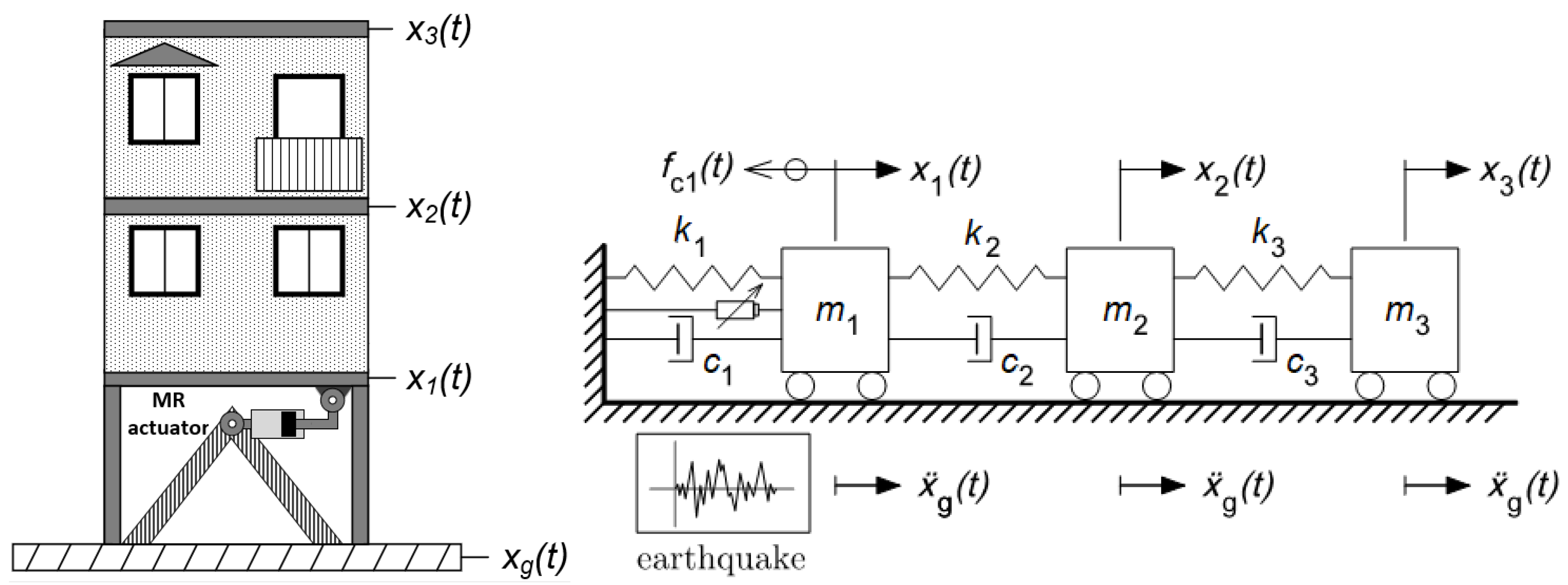
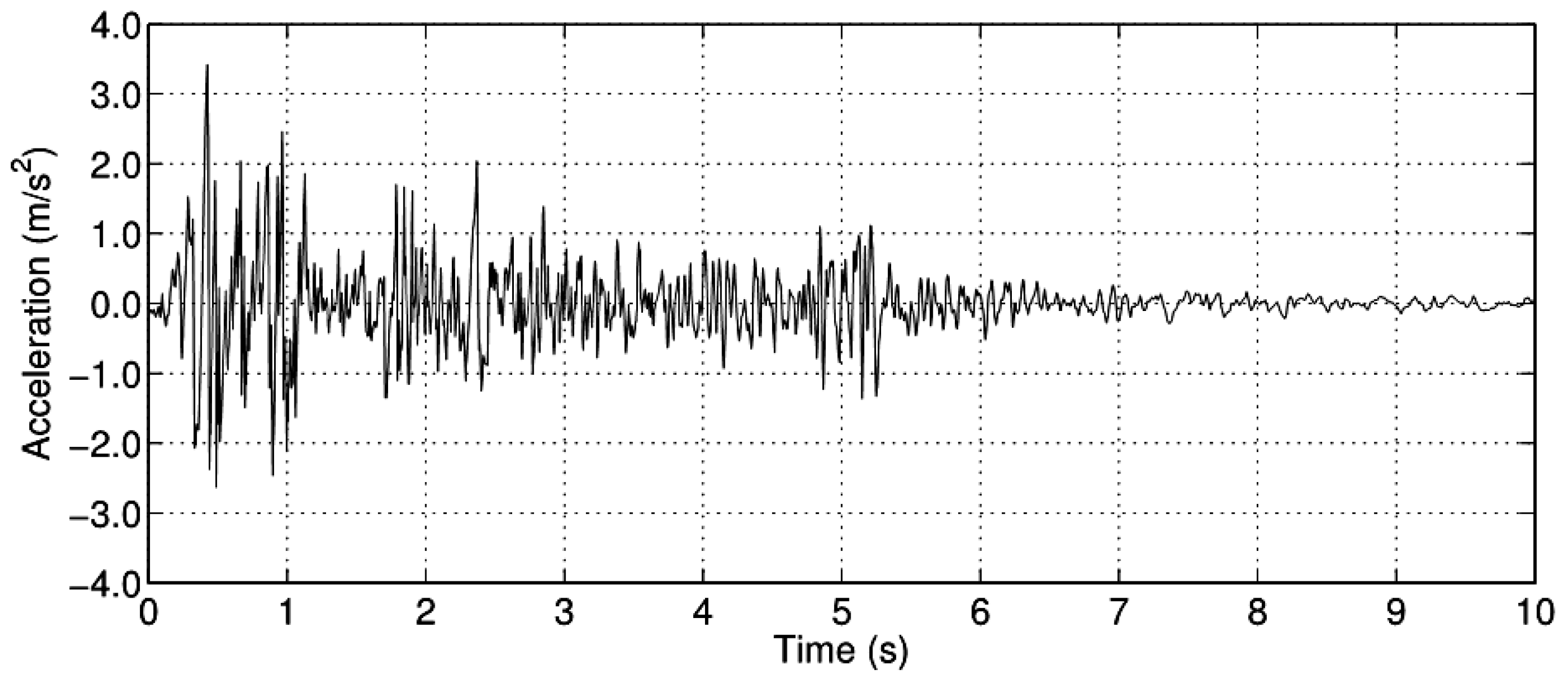
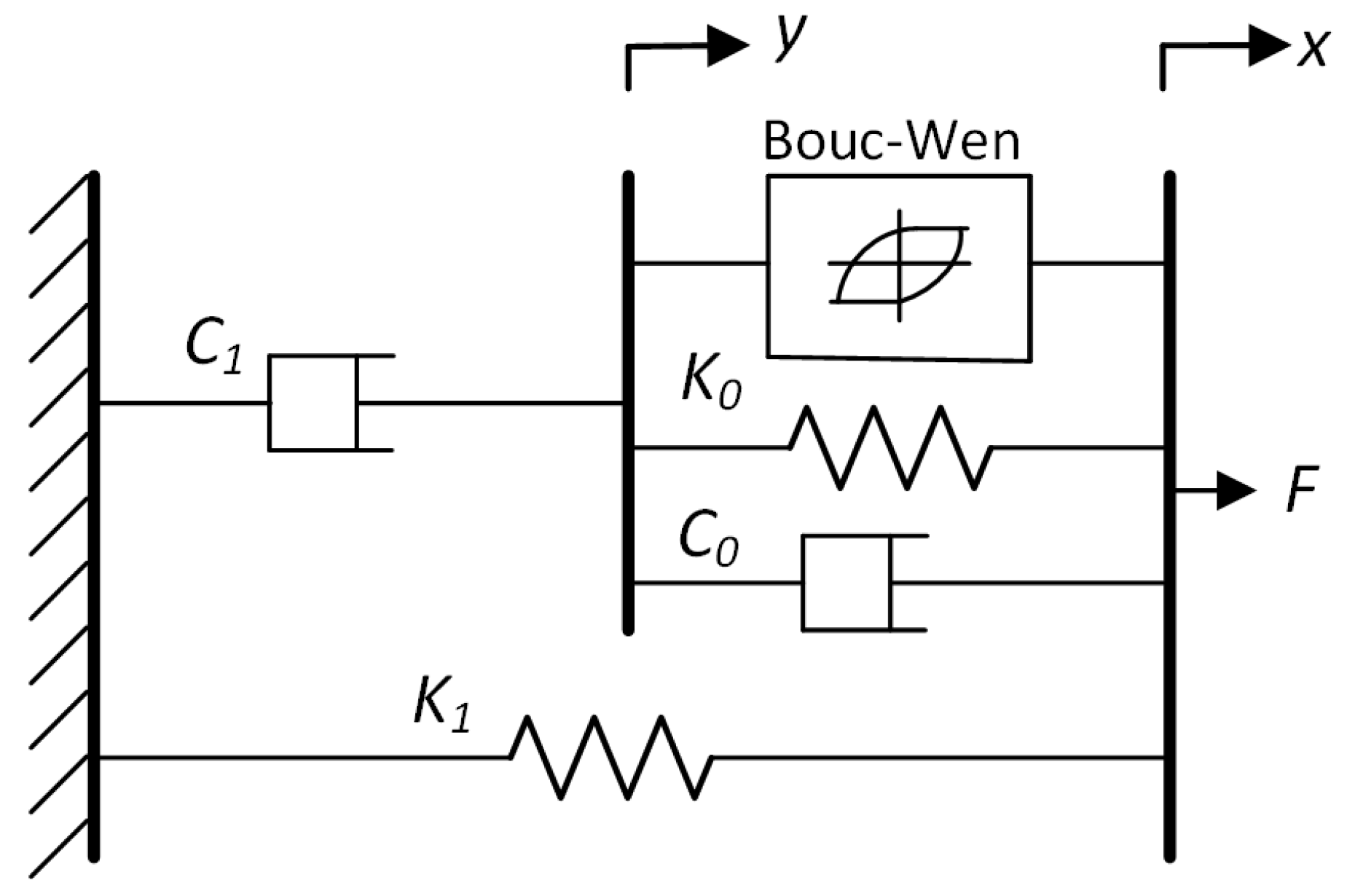

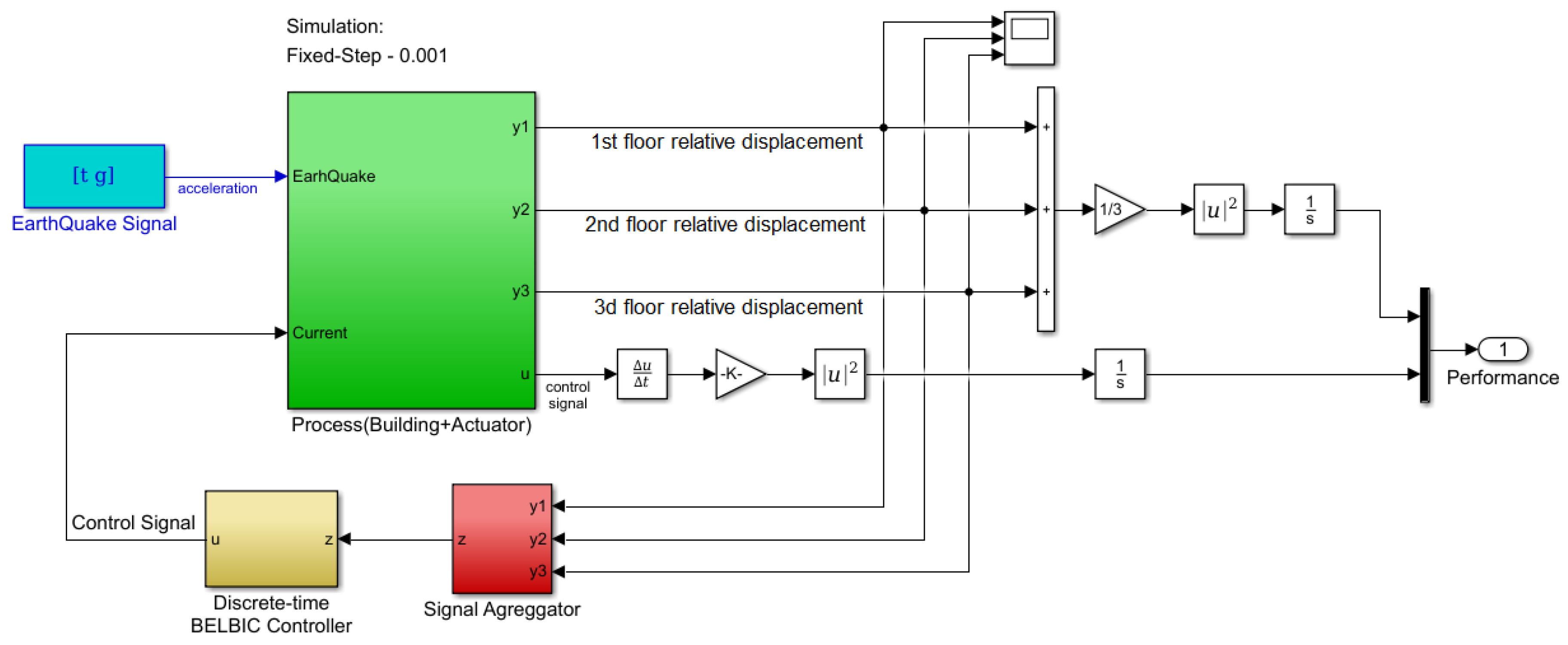
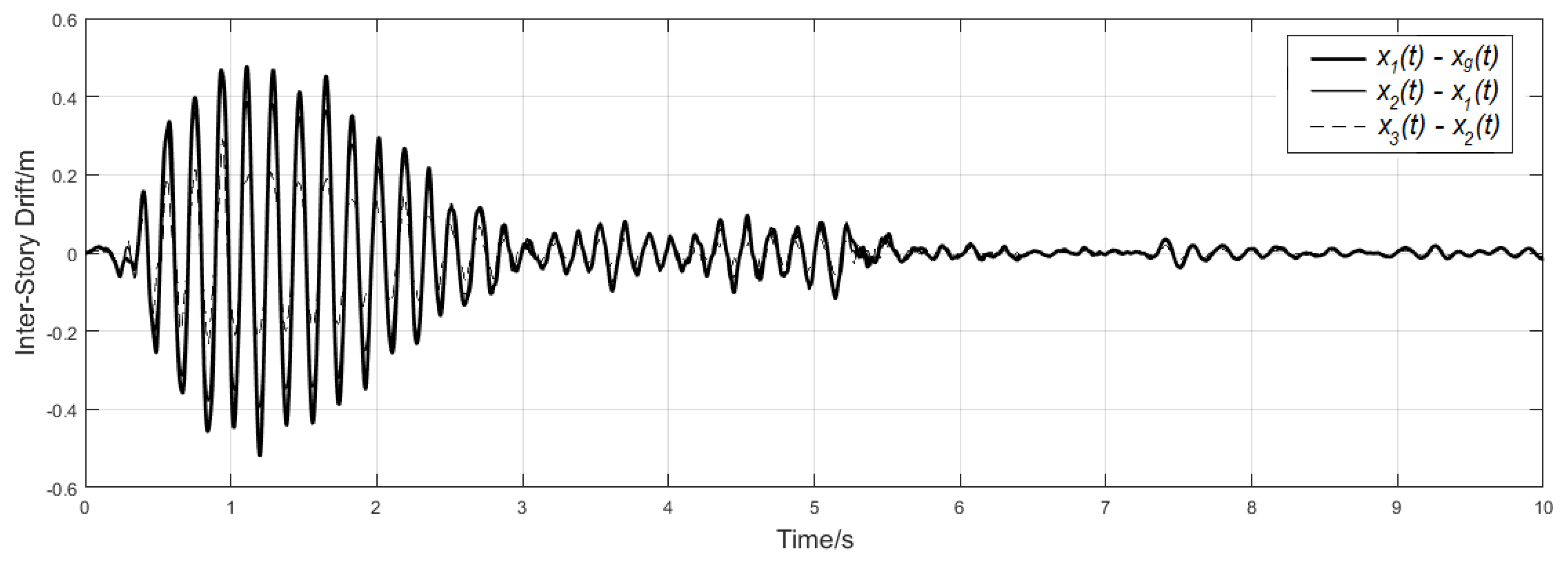
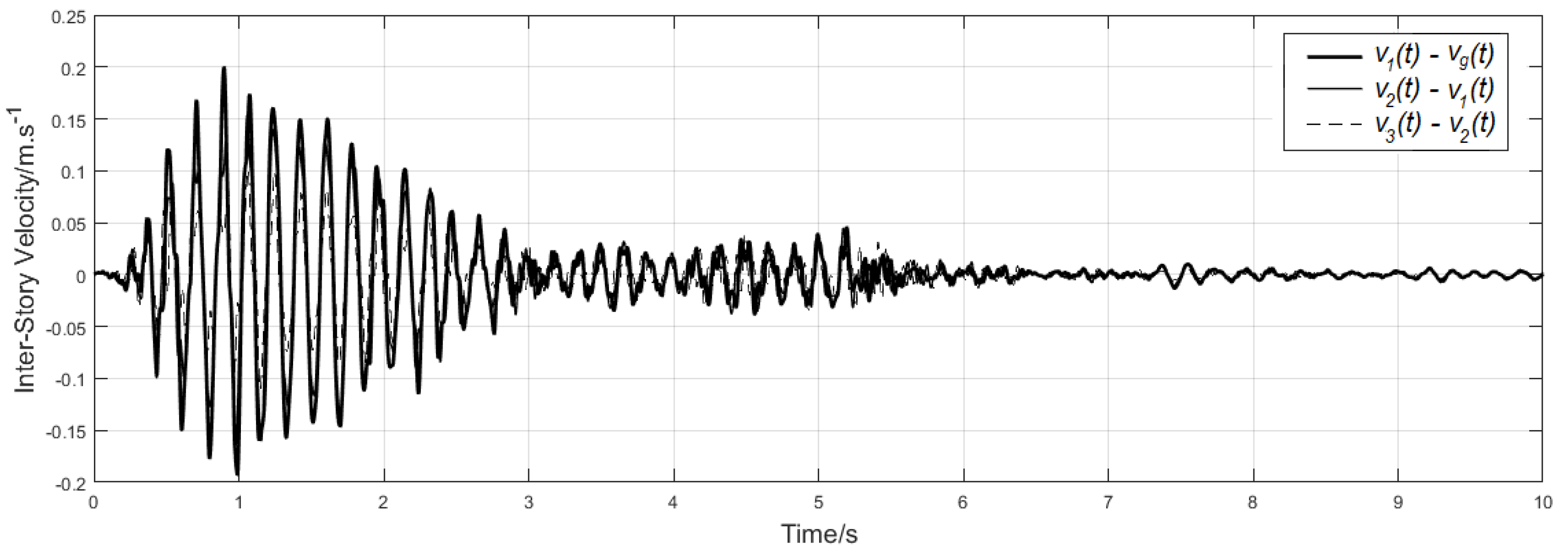
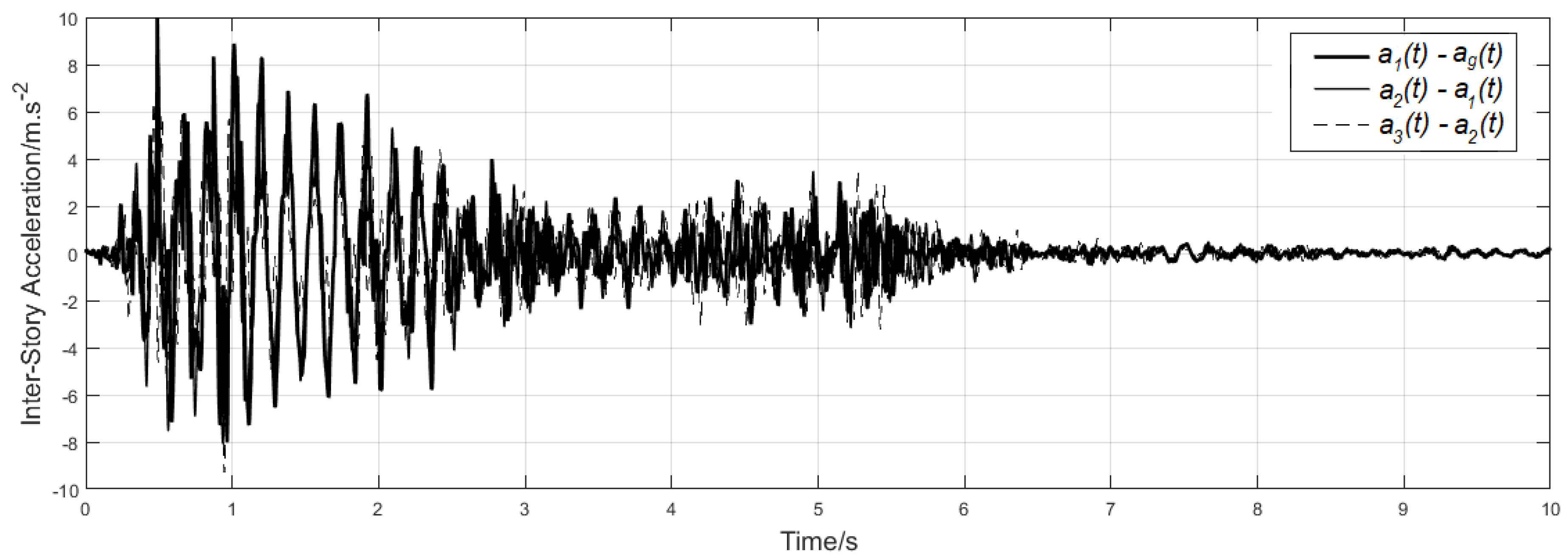
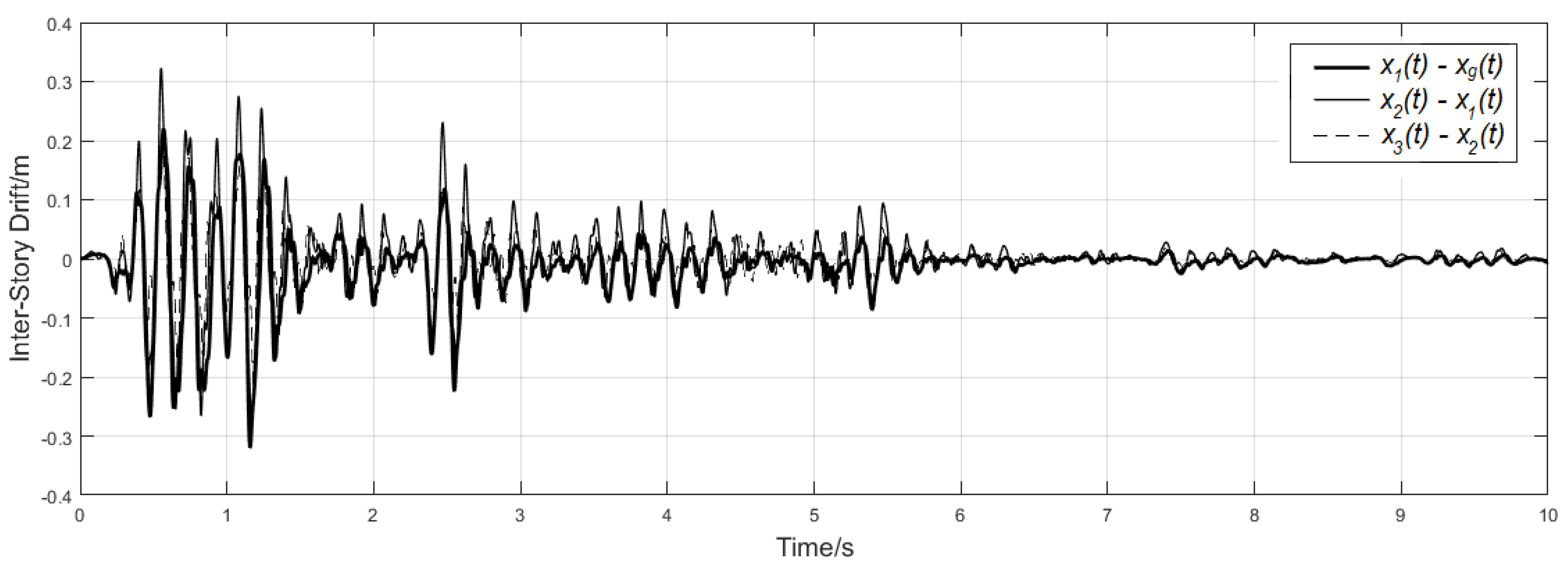
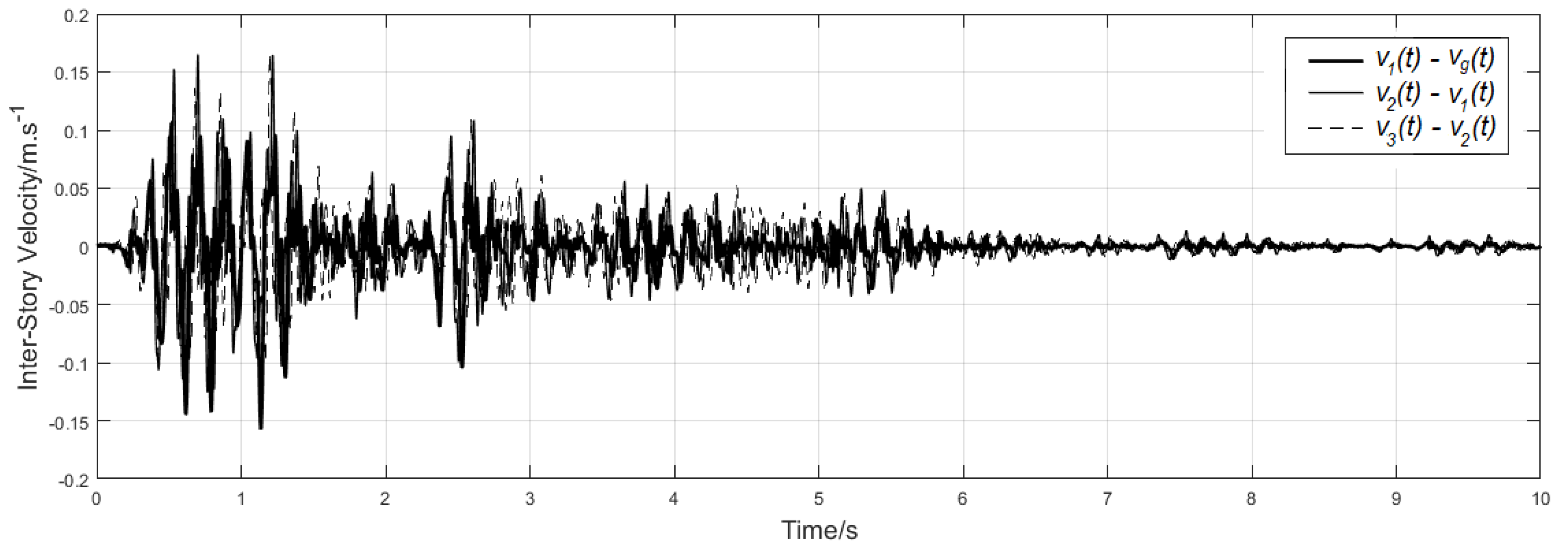
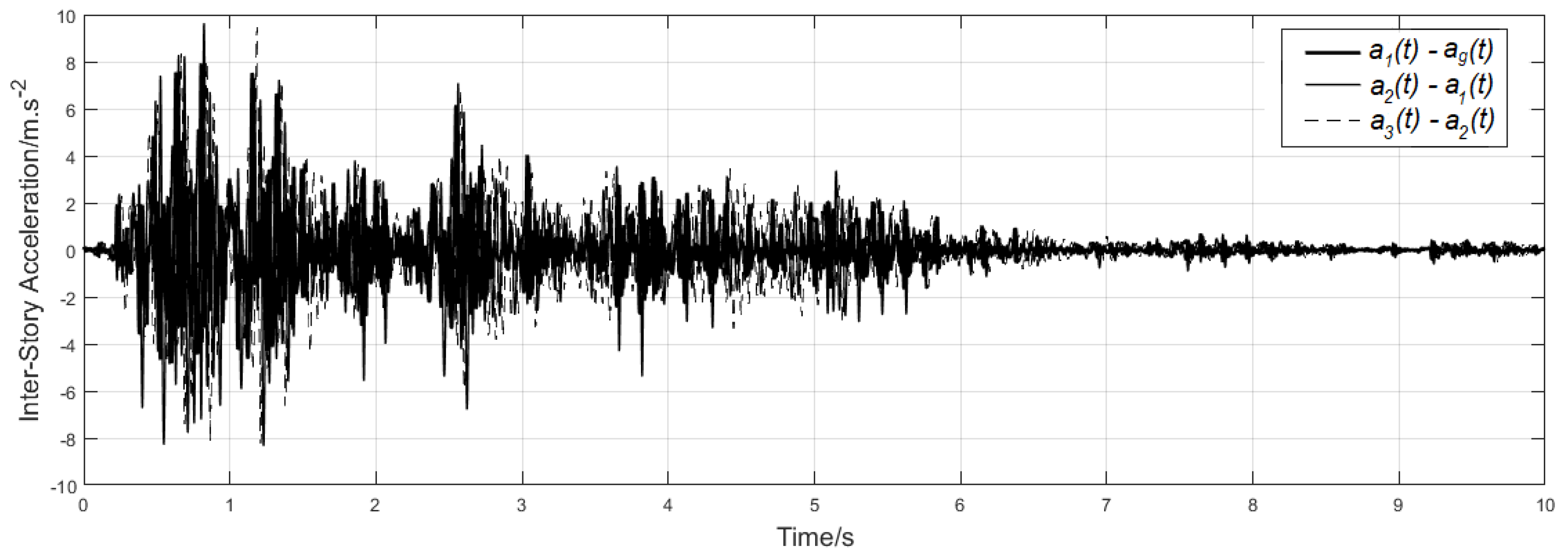
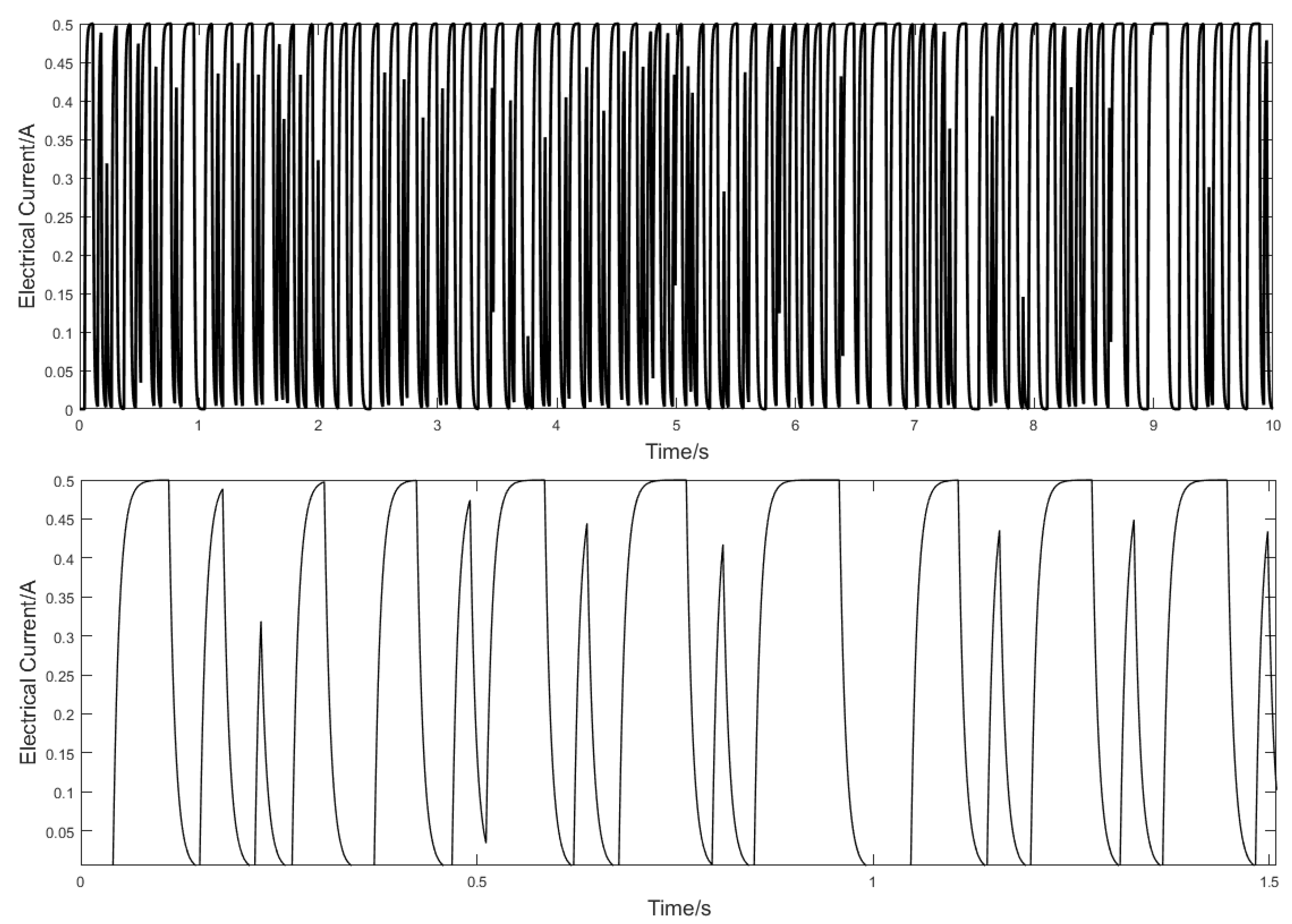
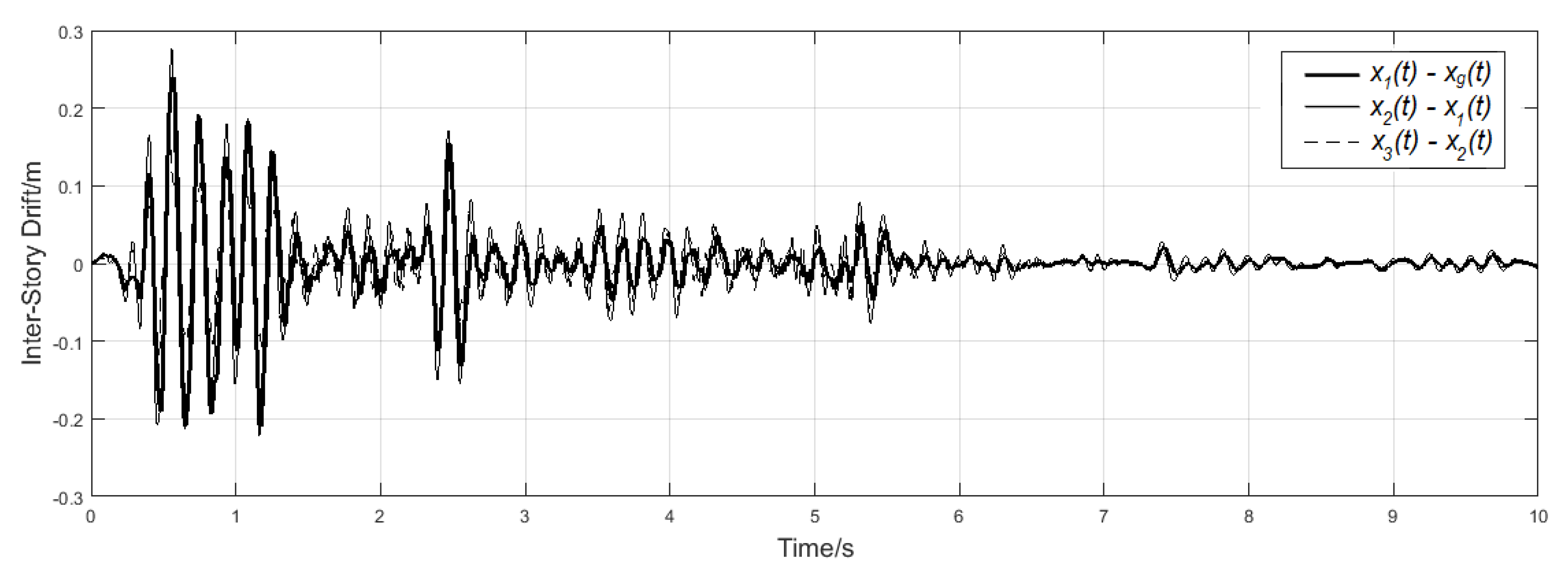

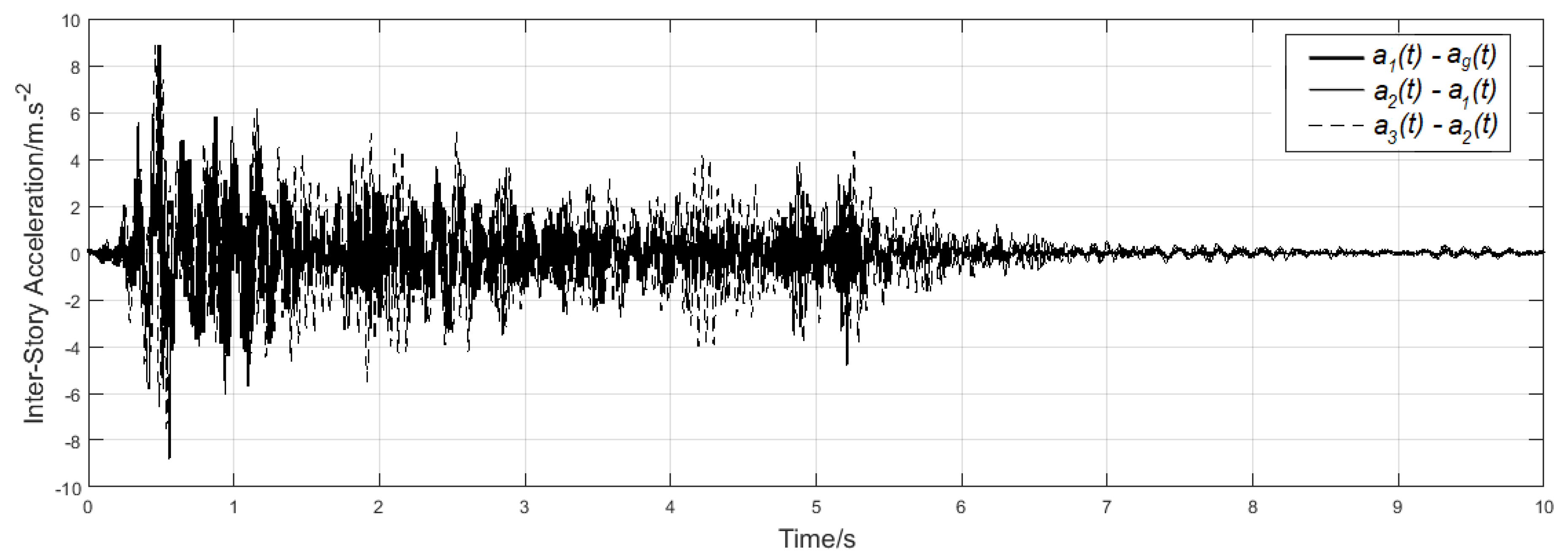
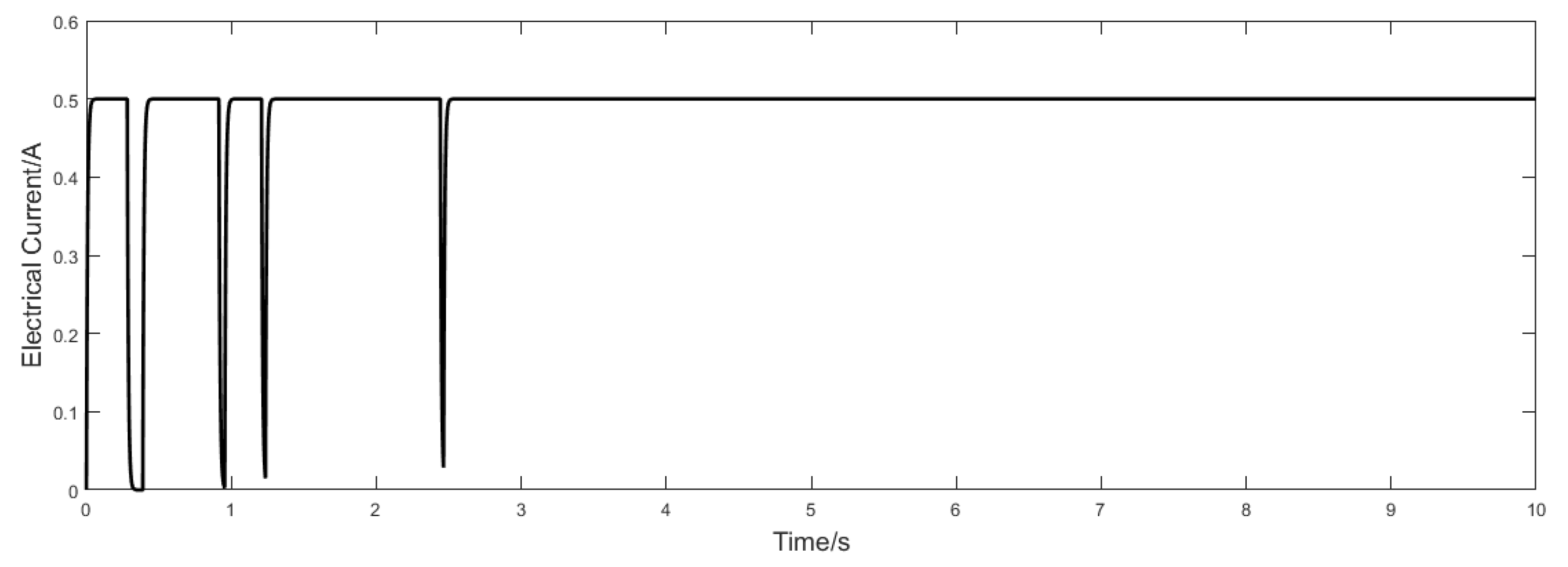

| Inter-storey drift/cm | |||
| RMS | 0.126 | 0.104 | 0.059 |
| Peak Value | 0.519 | 0.443 | 0.292 |
| Inter-storey velocity/ms | |||
| RMS | 0.0447 | 0.0374 | 0.0235 |
| Peak Value | 0.2 | 0.163 | 0.130 |
| Inter-storey acceleration/ms | |||
| RMS | 1.8 | 1.57 | 1.40 |
| Peak Value | 9.99 | 8.07 | 9.27 |
| V | W | |||||||||||
|---|---|---|---|---|---|---|---|---|---|---|---|---|
| 0.8 | 0.5 | 1.5 | 0 | −0.5 | 2 | 2 | 2 | 1 | 2 | 2 | 2 | 1 |
| Inter-storey drift/cm | |||
| RMS | 0.0538 | 0.058 | 0.037 |
| Peak Value | 0.319 | 0.323 | 0.224 |
| Inter-storey velocity/ms | |||
| RMS | 0.0222 | 0.0274 | 0.0232 |
| Peak Value | 0.157 | 0.162 | 0.126 |
| Inter-storey acceleration/ms | |||
| RMS | 1.78 | 1.46 | 1.38 |
| Peak Value | 9.98 | 8.01 | 9.21 |
| V | W | |||||||||||
|---|---|---|---|---|---|---|---|---|---|---|---|---|
| 0 | 0 | −2 | −2 | −2 | 0 | 0 | 0 | 0 | 0 | 0 | 0 | 0 |
| 1 | 1 | 2 | 2 | 2 | 2 | 2 | 2 | 2 | 2 | 2 | 2 | 2 |
| 0.436 | 0.0101 | 1.99 | 0.639 | 1.99 | 0.0002 | 0.00018 | 0.0001 | 0.0478 | 1.307 | 0.962 | 0.495 | 1.985 |
| Inter-storey drift/cm | |||
| RMS | 0.0442 | 0.0499 | 0.0307 |
| Peak Value | 0.240 | 0.277 | 0.177 |
| Inter-storey velocity/ms | |||
| RMS | 0.0167 | 0.0206 | 0.0172 |
| Peak Value | 0.0885 | 0.122 | 0.0918 |
| Inter-storey acceleration/ms | |||
| RMS | 0.952 | 1.291 | 1.28 |
| Peak Value | 8.879 | 7.98 | 8.823 |
© 2019 by the authors. Licensee MDPI, Basel, Switzerland. This article is an open access article distributed under the terms and conditions of the Creative Commons Attribution (CC BY) license (http://creativecommons.org/licenses/by/4.0/).
Share and Cite
Braz César, M.; Coelho, J.P.; Gonçalves, J. Semi-Active Vibration Control of a Non-Collocated Civil Structure Using Evolutionary-Based BELBIC. Actuators 2019, 8, 43. https://doi.org/10.3390/act8020043
Braz César M, Coelho JP, Gonçalves J. Semi-Active Vibration Control of a Non-Collocated Civil Structure Using Evolutionary-Based BELBIC. Actuators. 2019; 8(2):43. https://doi.org/10.3390/act8020043
Chicago/Turabian StyleBraz César, Manuel, João Paulo Coelho, and José Gonçalves. 2019. "Semi-Active Vibration Control of a Non-Collocated Civil Structure Using Evolutionary-Based BELBIC" Actuators 8, no. 2: 43. https://doi.org/10.3390/act8020043
APA StyleBraz César, M., Coelho, J. P., & Gonçalves, J. (2019). Semi-Active Vibration Control of a Non-Collocated Civil Structure Using Evolutionary-Based BELBIC. Actuators, 8(2), 43. https://doi.org/10.3390/act8020043






